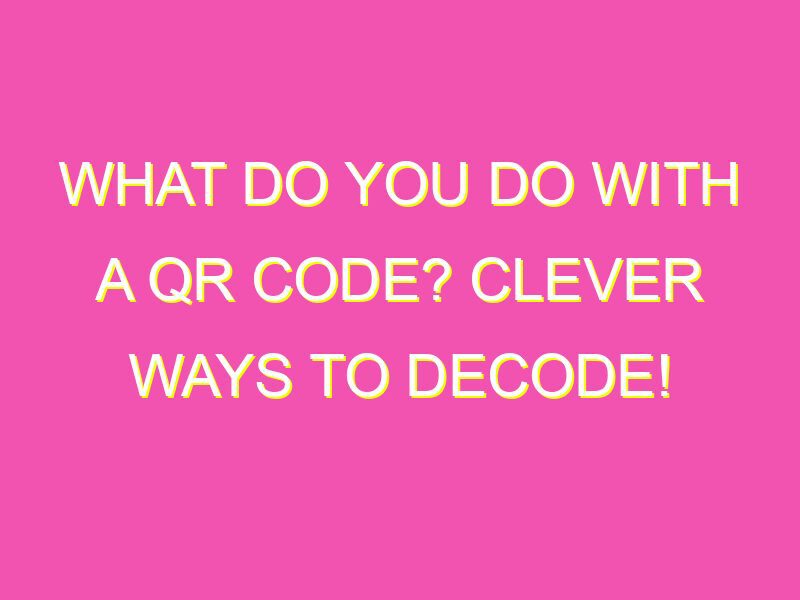Scared of QR codes? You should be! These little squares can lead you to a world of trouble with one tap of your phone. Danger could be lurking around the corner! But fear not, bold reader, with these easy steps you can stay safe and sound:
In conclusion, QR codes may be tricky, but they’re no match for the cautious user. Keep these tips in mind, and you’ll breeze through the world of QR codes with confidence and ease.
Introduction: What are QR codes and why are they popular?
QR codes, also known as Quick Response codes, have become increasingly popular over recent years. They are essentially two-dimensional barcodes that can be scanned using a smartphone camera to quickly and easily access any type of digital content. QR codes have become ubiquitous in advertising, marketing and even in everyday life. You’ve probably seen them on the packaging of grocery items or in marketing flyers.
QR codes have become such a popular tool for businesses due to the ease with which they can be used to connect with customers. They provide an easy way to quickly convey information to customers without having to type a long URL or other information into a search engine.
How to verify the legitimacy of a QR code before scanning it
Scanning a QR code can come with a level of risk, particularly when it comes to opening links within the code. Hackers have been known to create fake QR codes that lead to malicious websites or that could download unwanted software onto your device. Therefore, it’s important to verify the legitimacy of a QR code before scanning it. Here are some ways to do this:
- Look for a description of the QR code’s intended purpose. If it’s promotional or tied to a specific event, it’s more likely to be legitimate.
- Check whether the QR code is on an official website. If it’s on a site you don’t recognize, it’s better to be cautious than to take unknown risks.
- Double-check the QR code with the sender before scanning it. If you have any doubts about its legitimacy, always ask the sender before scanning the code.
The risks of scanning QR codes from unknown sources
Scanning QR codes from unknown sources can be risky, as mentioned earlier. You may not know what information you are getting, and depending on the nature of the QR code, you may get unwanted malware or spam on your device. Scanning QR codes can also lead to a compromise of your sensitive information, which can lead to identity theft or fraud.
It’s always best to exercise caution when it comes to scanning QR codes. If you are unsure about a particular QR code, it’s better to err on the side of caution and avoid scanning it altogether.
Contacting the sender to confirm the legitimacy of the QR code
One of the best ways to make sure a QR code is legitimate is to double-check with the sender. You can contact the sender through email, text message or social media, and ask them whether the QR code is genuine. If the sender can confirm that the QR code is legitimate, you can be more confident that it is safe to scan.
Best practices for scanning QR codes safely
When it comes to scanning QR codes, there are some best practices you can follow to reduce the risks involved. Here are some of the best ways to scan QR codes safely:
- Scan the QR code using a well-known QR code scanner. This reduces the risk of downloading unsafe software onto your device.
- Avoid scanning QR codes that do not have any explanation or context. They might be disguised as promotional or event-based codes, but if they don’t have any accompanying information, it’s better to avoid them.
- Never download anything from a QR code that you don’t recognize or trust. Only download from official websites and verified sources.
- Always update your anti-virus software.
Avoiding opening hyperlinks from strangers
Just as QR codes present risks, so too do hyperlinks from strangers. It’s always better to avoid opening links from strangers, as you can’t identify what kind of information you may be exposing your device or yourself to. Avoiding opening hyperlinks from strangers can also help to reduce the risk of being tricked by hackers, spammers or phishers.
Conclusion: Use caution when scanning QR codes
QR codes are a useful tool for businesses and consumers, but they can also be risky if not used with caution. It’s crucial to always verify the legitimacy of a QR code before scanning it and to follow best practices when scanning QR codes to reduce the risks involved. Remember, if you have any doubts about the legitimacy of a QR code, it’s better to be cautious and avoid scanning it altogether.





